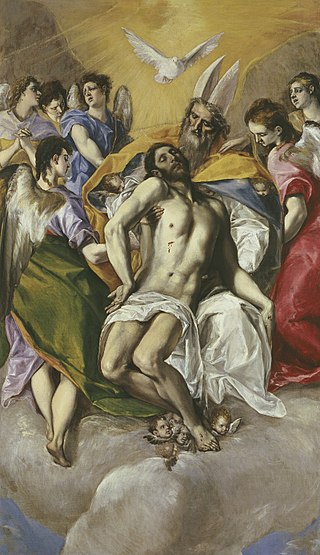
Bartolomé Esteban Murillo was a Spanish Baroque painter. Although he is best known for his religious works, Murillo also produced a considerable number of paintings of contemporary women and children. These lively realistic portraits of flower girls, street urchins, and beggars constitute an extensive record of the everyday life of his times. He also painted two self-portraits, one in the Frick Collection portraying him in his 30s, and one in London's National Gallery portraying him about 20 years later. In 2017–18, the two museums held an exhibition of them.

The Museo del Prado, officially known as Museo Nacional del Prado, is the main Spanish national art museum, located in central Madrid. It houses collections of European art, dating from the 12th century to the early 20th century, based on the former Spanish royal collection, and the single best collection of Spanish art. Founded as a museum of paintings and sculpture in 1819, it also contains important collections of other types of works. The numerous works by Francisco Goya, the single most extensively represented artist, as well as by Hieronymus Bosch, El Greco, Peter Paul Rubens, Titian, and Diego Velázquez, are some of the highlights of the collection. Velázquez and his keen eye and sensibility were also responsible for bringing much of the museum's fine collection of Italian masters to Spain, now one of the largest outside of Italy.

The Museo Nacional Centro de Arte Reina Sofía is Spain's national museum of 20th-century art. The museum was officially inaugurated on September 10, 1992, and is named for Queen Sofía. It is located in Madrid, near the Atocha train and metro stations, at the southern end of the so-called Golden Triangle of Art.

Juan de Pareja was a Spanish painter of multiracial descent. Born in Antequera, he is best known as a member of the household and workshop of painter Diego Velázquez, who enslaved Pareja until 1654. Pareja's 1661 painting The Calling of Saint Matthew is currently on display at the Museo del Prado in Madrid.

Maria Isabel of Braganza was a Portuguese infanta who became Queen of Spain as the second wife of King Ferdinand VII.

The Second of May 1808, by Goya, also known as The Charge of the Mamelukes, is a painting by the Spanish painter Francisco Goya. It is a companion to the painting The Third of May 1808 and is set in the Calle de Alcalá near Puerta del Sol, Madrid, during the Dos de Mayo Uprising. It depicts one of the many people's rebellions against the French occupation of Spain that sparked the Peninsular War.

.

Charles-Joseph Flipart (1721–1797) was a French painter and engraver.

The Colossus, is known in Spanish as El Coloso and also El Gigante, El Pánico and La Tormenta. It is a painting traditionally attributed to Francisco de Goya that shows a giant in the centre of the canvas walking towards the left hand side of the picture. Mountains obscure his legs up to his thighs and clouds surround his body; the giant appears to be adopting an aggressive posture as he is holding one of his fists up at shoulder height. A dark valley containing a crowd of people and herds of cattle fleeing in all directions occupies the lower third of the painting.

Doña Antonia de Ipeñarrieta y Galdós and Her Son Don Luis is a 1634 portrait by Diego Velázquez, now in the Prado Museum. Doña Antonia and her son Luis are shown standing, captured in an elegant melancholy. The woman uses the chair to support herself, to emphasize her social status in the Court, where she had the right to sit. According to different studies of the canvas, it is believed that the child's figure could have been added afterwards.

The Jester Barbarroja is an oil on canvas portrait by Diego Velázquez of Cristóbal de Castañeda y Pernia, nicknamed Barbarroja in his role as a jester at the court of Philip IV of Spain from 1633 to 1649. The painting is now in the Museo del Prado. It was in the Palacio del Buen Retiro in Madrid in 1701, one of six portraits of court jesters in the Queen's quarters. From 1816 to 1827 it was in the Real Academia de Bellas Artes de San Fernando.

The Monastery of Saint Dominic of Silos (the Old) (Spanish: Monasterio de Santo Domingo de Silos (el Antiguo)) is a Cistercian convent in Toledo, Spain.

The Royal Tapestry Factory is a factory making tapestries in Madrid, Spain, which was founded in 1720 and is still in operation.

The Mural Paintings from the Herrera Chapel is a group of mural paintings by Annibale Carracci and collaborators, of around 1602, now divided between the National Art Museum of Catalonia in Barcelona, and the Museo del Prado in Madrid.

José Gabriel de Silva-Bazán y Waldstein, 10th Marquess of Santa Cruz de Mudela, was a Spanish noble, first director of the Prado Museum between 1817 and 1820 and Mayordomo mayor between 1822 and 1823.
Andres Rossi was a Spanish artist. He worked as a painter, draughtsman, print maker, sculptor and writer in Madrid and Seville.
Francisco Javier Sánchez Cantón (1891–1971) was a Spanish art historian, who from 1960 to 1968 was Director of the Museo del Prado.

The Spanish royal collection of art was almost entirely built up by the monarchs of the Habsburg family who ruled Spain from 1516 to 1700, and then the Bourbons. They included a number of kings with a serious interest in the arts, who were patrons of a series of major artists: Charles V and Philip II were patrons of Titian, Philip IV appointed Velázquez as court painter, and Goya had a similar role at the court of Charles IV.

Holy Trinity is a c.1577–1579 oil on canvas painting by El Greco, one of nine works he produced for the Convent of Santo Domingo el Antiguo (Toledo). Ferdinand VII of Spain acquired it from the sculptor Valeriano Salvatierra in 1832 and it now hangs in the Prado Museum in Madrid.
















